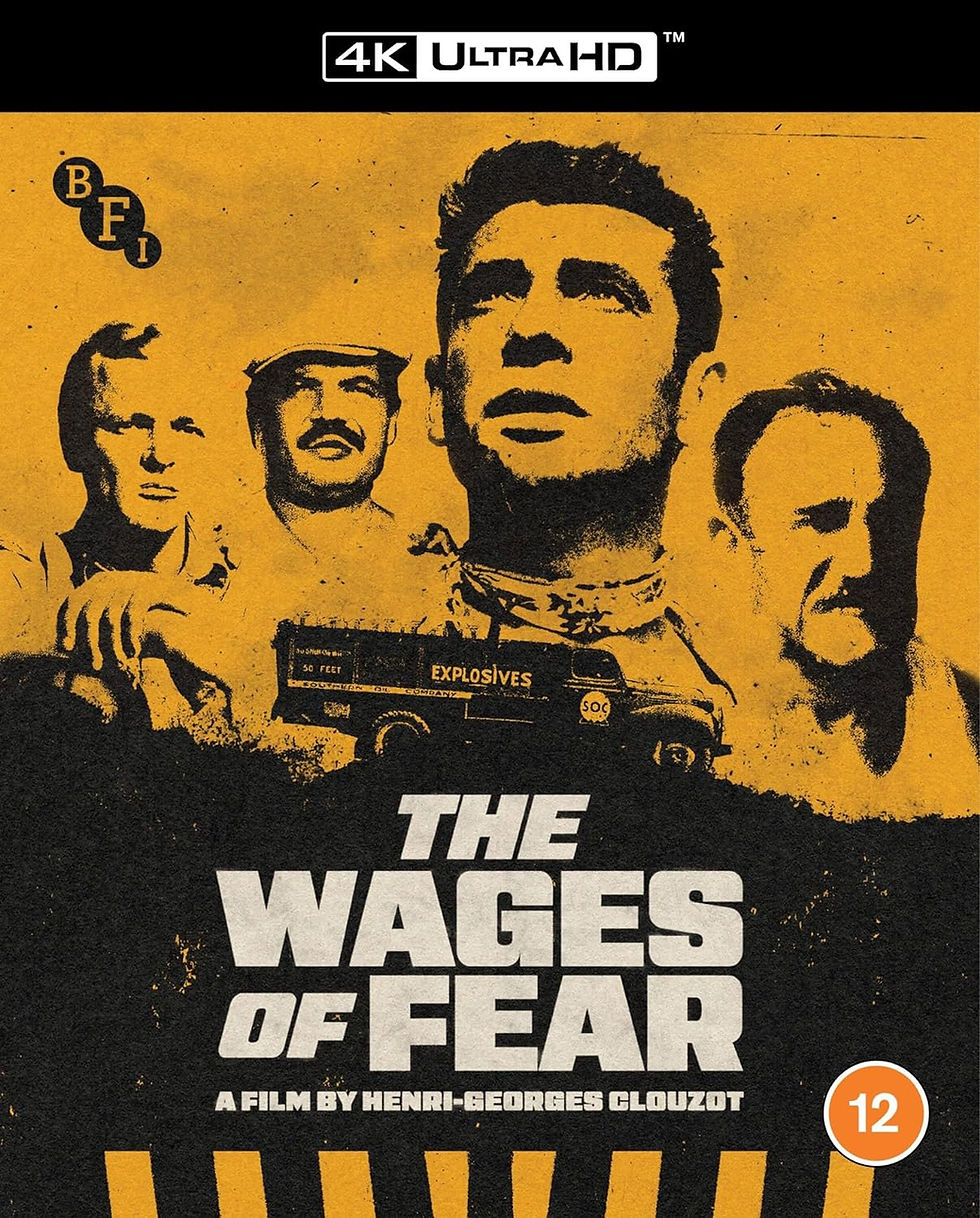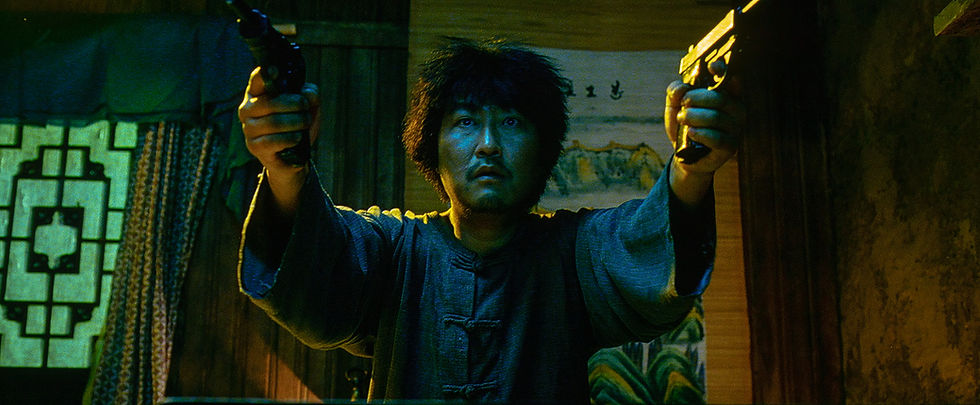Clouzot’s masterful ‘The Wages of Fear’ grips you even tighter in 4K
- Craig Shapiro

- Mar 13, 2024
- 5 min read
Updated: Mar 14, 2024
4K ULTRA HD REVIEW / HDR SCREENSHOTS
In one of the film’s most iconic sequences, Mario (Yves Montand) pulls Jo (Charles Vanel) from an oil pool. They’ve taken on a suicide mission – to drive a truckload of nitroglycerine over 300 miles of treacherous terrain to fight an oil fire. Their incentive? $2,000 from the American Southern Oil Company.
(Click an image to scroll the larger versions)
“THE WAGES OF FEAR”
4K Ultra HD, 1953, French with English subtitles, unrated, adult themes, white-knuckle tension, violence
Best extras: The booklet featuring a profile of director-writer Henri-Georges Clouzot and archival reviews of the film, and a new video essay by filmmaker Nic Wassell
TO SAY THAT “The Wages of Fear,” the Grand Prix winner at Cannes, wasn’t enthusiastically received by some critics is a colossal understatement. The unrelenting tension and technical prowess that defined its second half were inarguable; it’s the first half where they took issue.
Filmmaker/critic Karel Reisz, writing in 1954 in the British Film Institute magazine Sight & Sound, says director-writer Henri-Georges Clouzot (“Diabolique”) makes “no real statement” about his characters, that “(they) excite no sympathy.” The film, he concludes, “is unselectively and impartially anti-everything.” Pointing to its “unrelieved pessimism,” another critic, writing the same year in the BFI’s Monthly Film Bulletin, dismissed it as “unlikeable.”
Both reviews are included in the booklet put together by the BFI for “The Wages of Fear’s” 4K release. It also includes “They Took a Chance and Lost. That’s Life,” an essay by author Andy Miller that details Clouzot’s motivation. Branded as a collaborator after World War II and banned from working in France for four years, he was liberated by the “blanket condemnation” that followed the release of 1943’s Le Corbeau, described by Miller as “a withering study of French provincial faithlessness” that offended the occupying Nazis and moviegoers alike.
(1) “The Wages of Fear,” which won the Grand Prix at Cannes, made Montand an international star. (2) Véra Clouzot, the wife of writer-director Henri-Georges Clouzot, plays Mario’s lover, Linda. (3-4) Stuck in a Latin American backwater with no prospects, the men waste the day under the canopy of the saloon. (5-7) Jo arrives on the daily flight to the oil company airport and, after bribing his way in, finds a village of desperate men and women.
Given his newfound “existential autonomy,” Clouzot from then on made the films that he wanted to make, Miller writes. He spends the first hour of “Wages,” remade by William Friedkin as the gripping “Sorcerer” in 1977, on his four protagonists for two reasons: to make audiences feel as if they know them and to expose the film’s politics. Decidedly anti-American, it was trimmed for its States-side release. Audiences were confused.
Filmmaker Nic Wassell (“The Distant Sea”) goes further in his excellent 2023 video essay, “A Road Trip out of Hell? Or Into It? Purgatory and The Wages of Fear.” Calling it “a classic film of existential terror,” he says that it embodies Jean-Paul Sartre’s maxim that, “Man is nothing else but what he purposes … nothing else but the sum of his parts.”
Just one thing: Save the booklet and Wassell’s essay until after you watch the movie.
In a squalid, unnamed Latin American village, four desperate men – the Corsican playboy Mario (Yves Montand, “Z”), the mid-level criminal Jo (Cannes best actor winner Charles Vanel), the Italian bricklayer Luigi (Folco Lulli, “The Organizer”) and Bimba, a German survivor of a Nazi slave-labor camp (Peter Van Eyck, “The Longest Day”) – are hired by an American oil company to drive two truckloads of nitroglycerine 300 miles across treacherous terrain to fight an oil fire. The American boss O’Brien (William Tubbs, “Paisan”) makes no secret that it’s a suicide mission. Each man will get $2,000 – their ticket out.
Adapting Georges Arnaud’s 1950 novel, Clouzot portends what lies ahead in the opening shot of a young boy tormenting four cockroaches that he’s bound together with string, an allegory that Sam Peckinpah repurposed in his 1969 masterwork “The Wild Bunch,” where children watch as a swarm of fire ants overwhelm three scorpions.
And that’s all that you’re going to get here.
(1) Mario is taken in by Jo’s bravado and charisma, but their partnership deteriorates once they get underway. (2) Italian bricklayer Luigi (Folco Lulli) demains more drinks from saloon owner Pepito (Dario Moreno). (3) Vanel’s career was in a slump until his performance as Jo won the Best Actor award at Cannes. (4) Aboriginals keep their distance as the oil fire rages.
VIDEO/AUDIO
Like it did nearly two years ago with Michael Caine’s iconic 1971 gangster film “Get Carter,” the BFI delivers with “The Wages of Fear” (1.37:1 aspect ratio). Some reviewers have noted that they can’t say this native 4K version is head-and-shoulders better than the BFI’s 2017 Blu-ray because the latter is pretty darned good. But if you don’t have it, this is the one to get.
Amen to that. The images don’t give away a trace of their age – contrasts are razor-sharp, the shadows could not be deeper, and there isn’t a speck of dirt anywhere. In a word (or two), the B&W cinematography by Armand Thirard (“Diabolique”) is glorious, whether his camera is trained on the hair-raising demolition of a boulder blocking the trucks’ passage, Mario as he drives through a ruptured oil line, or the burning fields. The HDR10 and Dolby Vision grading does make a difference and everything is encoded onto a 100 GB disc and varies from 46 Megabits per second to the low 90 Mbps.
There’s only one audio option, the French DTS-HD Master Audio 2.0. While it’s not as robust as you might like, the dialogue and effects are plenty clear and the evocative score by Georges Auric (“Rififi”) gets a good ride. Oh yeah, the English subtitles are perfectly sized and weighted.
EXTRAS
The BFI has done first-class work here, too. The 25-page booklet and Wassell’s essay head the list, but don’t stop there.
Also included are a 2017 interview with Professor Lucy Mazdon, Film Studies chair at the University of Southampton; a 2017 commentary with Australian critic Adrian Martin; a lengthy discussion with Montand (from 1989), and interviews with “Wages’” assistant director Michel Romanoff and Clouzot biographer Marc Godin, both from the 2009 Criterion Collection release.
Topping the impressive package off are three short films from the BFI National Archive: “They Take the High Road” (1960), “Fire Checked by Explosives” (1928), and “Transportation Loads –With or Without Roads” (1920).
Send the kids to bed and buckle up. This one is strictly for Mom and Dad.
– Craig Shapiro
The treacherous mission
Mario and Jo set out on their nail-biting journey and, along with Bimba (Peter Van Eyck) and Luigi (Folco Lulli) in a second truck, are faced with obstacles almost from the start. After negotiating a rickety bridge, the trucks back onto a platform and turn around when the road is blocked by a boulder. The tension is ratcheted up even more as some of the nitro is used to clear the way and knocks Luigi unconscious.
(1) A pool of oil from a ruptured pipe blocks Mario and Jo’s passage. (2-4) Jo guides the truck through, but is fatally injured when Mario drives over him. His final words are, “There’s nothing.”






















































Comments